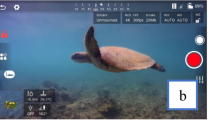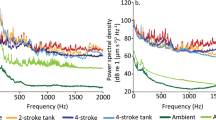Abstract
OVER the past 50 years there has been much speculation about the energetic cost of swimming and wave-riding by dolphins1–11. When aligned properly in front of the bow of moving ships1–3, in the stern wake of small boats4,5, on wind waves6, and even in the wake of larger cetaceans7–9, the animals appear to move effortlessly through the water without the benefit of propulsive strokes by the flukes. Theoretically, body streamlining as well as other anatomical and behavioural adaptations contribute to low transport costs in these animals. The economy of movement permitted by wave-riding has been perceived as an energetic advantage for the swimming dolphin2,310, but has been hard to prove in the absence of physiological data for exercising cetaceans. Here we determine the aerobic and anaerobic costs of swimming and wave-riding in bottlenose dolphins and find that the minimum cost of transport for swimming dolphins is 1.29±0.05 J kg-1 m-1 at a cruising speed of 2.1 m s-1. Aerobic costs are nearly twice as high for swimming seals and sea lions, and 8–12 times higher for human swimmers12. Wave-riding by dolphins provides additional benefits in terms of speed. The results indicate that behavioural, physiological and morphological factors make swimming an economical form of high-speed travel for dolphins.
This is a preview of subscription content, access via your institution
Access options
Subscribe to this journal
Receive 51 print issues and online access
$199.00 per year
only $3.90 per issue
Buy this article
- Purchase on Springer Link
- Instant access to full article PDF
Prices may be subject to local taxes which are calculated during checkout
Similar content being viewed by others
References
Scholander, P. F. Science 129, 1085–1087 (1959).
Norris, K. S. & Prescott, J. H. Univ. Calif. Publns Zool. 63, 291–402 (1961).
Shane, S. H., Wells, R. S. & Wursig, B. Mar. Mammal Sci. 2, 34–63 (1986).
Ridgway, S. H., Scronce, B. L. & Kanwisher, J. Science 166, 1651–1654 (1969).
Ridgway, S. H. in Mammals of the Sea: Biology and Medicine (ed. Ridgway, S. H.) 590–747 (Thomas, Springfield, Illinois, 1972).
Woodcock, A. H. & McBride, A. F. J. exp. Biol. 28, 215–217 (1951).
Wursig, B. & Wursig, M. Fishery Bull. 77, 399–412 (1979).
McBride, A. F. & Kritzler, H. J. Mammal. 32, 251–266 (1951).
Lang, T. G. in Whales, Dolphins and Porpoises (ed, Norris, K. S.) 410–432 (Univ. Calif. Press, Berkeley, 1966).
Hertel, H. in The Biology of Marine Mammals (ed. Andersen, H. T.) 31–63 (Academic, New York, 1969).
Gray, J. J. exp. Biol. 13, 192–199 (1936).
Williams, T. M., Kooyman, G. L. & Croll, D. A. J. comp. Physiol. B 160, 637–644 (1991).
Ponganis, P. J., Kooyman, G. L., Zornow, M. H., Castellini, M. A. & Croll, D. A. J. comp. Physiol. B 160, 473–482 (1990).
Zar, J. H. Biostatistical Analysis (Prentice-Hall, Englewood Cliffs, NJ. 1974).
Williams, T. M. & Kooyman, G. L. Physiol. Zool. 58, 576–589 (1985).
Lang, T. G., & Pryor, K. Science 152, 531–533 (1966).
Brett, J. R. J. Fish. Res. Board Can. 21, 1183–1226 (1964).
Schmidt-Nielsen, K. Science 177, 222–228 (1972).
Fedak, M. A. in Diving in Mammals and Man (eds Brubakk, A., Kanwisher, J. W. & Sundnes, G.) 11–32 (Tapir, Trondheim, Norway, 1986).
Homer, I. J. appl. Physiol. 33, 502–509 (1972).
Au, D. & Weihs, D. Nature 284, 548–550 (1980).
Blake, R. W. J. mar. Biol. Assoc. 63, 61–70 (1983).
Bartholomew, G. A. in Animal Physiology: Principles and Adaptations (ed. Gordon, M. S.) 57–110 (Macmillan, New York, 1977).
Aleyev, Yu. G. Nekton (Junk, The Hague, Holland 1977).
Williams, T. M. et al. J. mar. Biol. Assoc. 71, 727–728 (1991).
Goforth, H. W. Jr. in The Bottlenose Dolphin (eds Leatherwood, S. & Reeves, R. R.) 559–574 (Academic, San Diego, 1990).
Williams, T. M. J. comp. Physiol. A 164, 815–824 (1989).
Author information
Authors and Affiliations
Rights and permissions
About this article
Cite this article
Williams, T., Friedl, W., Fong, M. et al. Travel at low energetic cost by swimming and wave-riding bottlenose dolphins. Nature 355, 821–823 (1992). https://doi.org/10.1038/355821a0
Received:
Accepted:
Issue Date:
DOI: https://doi.org/10.1038/355821a0
This article is cited by
-
Assessing data bias in visual surveys from a cetacean monitoring programme
Scientific Data (2022)
-
Common dolphin (Delphinus delphis) fission–fusion dynamics in the south coast of Portugal
Behavioral Ecology and Sociobiology (2022)
-
A biologging perspective to the drivers that shape gregariousness in dusky dolphins
Behavioral Ecology and Sociobiology (2019)
-
Effects of vessel traffic and underwater noise on the movement, behaviour and vocalisations of bottlenose dolphins in an urbanised estuary
Scientific Reports (2017)
Comments
By submitting a comment you agree to abide by our Terms and Community Guidelines. If you find something abusive or that does not comply with our terms or guidelines please flag it as inappropriate.



